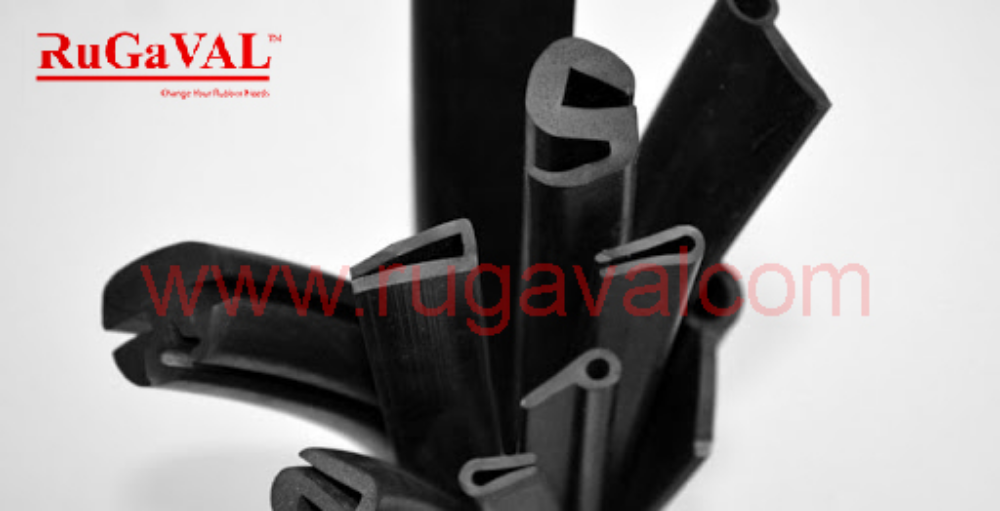Product Description
Rubber Extrusion | Extruded Rubber | Rubber Strip | L shaped Rubber Strip | U shaped Rubber
Rubber Extrusion
RUGAVAL fast becoming the market leader in the mass production,
and supply of solid rubber strip, not only within the Malaysia,
but throughout the world too. Solid rubber strip plays a
crucial part in sealing and spacing throughout a multitude of
different industrial sectors.
Applications
Because rubber extrusion allows for high levels of customizability and yields products with superior uniformity and strength, it is the preferred rubber processing method of most manufacturers.
Extruded rubber profiles appeal to manufacturers and customers in many industries, including: electronics, automotive manufacturing, aerospace, appliance, sports and recreation, industrial cleaning, marine and flooring. Within these industries, extruded rubber parts serve applications including, among others: moisture control, climate control, insulation, parts connection, floor safety and waterproofing.
Products Produced
Rubber extruders make a wide range of shapes and products that are invaluable in everyday home life, such as rubber trim, weather-stripping, extruded rubber seals, rubber floor matting, rubber grommets, connectors, bumpers and more. In general, rubber extrusions are valued as sealants and gaskets because they offer such excellent flexibility, impermeability and resilience. They even make up the eraser on the end of a pencil. Outside of the home, rubber extrusions are used in cars, on bicycles, on space shuttles and on submarines. In warehouses and manufacturing facilities, rubber rollers, sheets and rods absorb the noise and vibration caused by moving machinery.
Materials Process
The properties of an individual finished product depend on the raw rubber stock used to make it, the extrusion process it undergoes, and any secondary processes. Since rubber exists in many unique forms, rubber extrusion manufacturers are able to further develop their products through raw material selection.
Natural Rubber
Natural rubber, which is also called gum rubber, is sought after for its qualities of excellent acid and abrasion resistance.
Silicone Rubber
Silicone rubber is an FDA-certified non-reactive elastomer. It is chemically inert and does not react to biological fluids. In addition, it maintains its form and properties when exposed to both high and low temperatures, typically between -55℃ (-67℉) and 300℃ (572℉). Because of its superior qualities, silicone is popular for use in food service and healthcare.
Nitrile
Nitrile, a synthetic rubber copolymer, is highly resistant to oils, and so it is used to make rubber products that will encounter oil, like O-rings, hoses or hydraulic seals. Nitrile is also known as nitrile rubber, NBR (nitrile butadiene rubber), acrylonitrile butadiene rubber, Perbunan or Buna-N.
Neoprene
Neoprene resists heat, fire, UV rays, water and oil. It also has a high tensile strength.
SBR
SBR (styrene-butadiene rubber) is high abrasion resistant. For this reason, it’s used in a lot of automotive applications, like motor mount fabrication and belt cover fabrication.
EPDM
EPDM (ethylene propylene diene terpolymer) is resistant to many potential damages, including: heat, aging, ozone, oxidation and ultraviolet rays. It has many applications, including: sponge rubber, foam rubber, weather-stripping, tarp straps, door gaskets, window gaskets and roofing membrane.
Process Details
RUGAVAL RUBBER conduct a standard rubber extrusion job with a standard rubber extruder. After they have completed the design phase, which involves creating the die and selecting the material, they move on to extrusion with the extruder.
1. Pre-heat the stock until it is molten for hot extrusion. If you skip this step, you are doing what is called “cold extrusion,” or depending on the application, “cold feed extrusion.”
2. Feed unvulcanized rubber into the hopper, a container suspended above the conveyor.
3. With the help of gravity, send the rubber stock through the bottom of the hopper and out onto the conveyor.
4. The conveyor, along with a rotating screw, move the rubber towards the die. The screw creates pressure and temperature, which also helps push the rubber onward.
5. After it has reached the end of the conveyor, and has softened enough, the rubber passes through the opening of the die.
6. As the rubber passes through the die, it swells and takes on its shape.
7. After passing through the die, the rubber emerges from the other side of the extruder, now a shaped profile that matches the die.
8. Post-Processing
After you’ve processed the rubber profile, you may engage in any number of post-processing or secondary processes. Examples include: vulcanization, dusting (powder is applied to rubber to prevent it from adhering to something else), cutting, drilling, coiling, splicing and taping end joining. Of these, vulcanization is not optional.
Vulcanization
Vulcanization is a popular method of strengthening extruded rubber. During vulcanization, you cure the extruded rubber with Sulphur or other curative compounds.
Design
To create a custom rubber extrusion, RUGAVAL RUBBER think about a number of design factors, all related to the application. One of the first things they think about is material. Material choice depends entirely on how it will match the application requirements. Then, they plan out the shape of the die. They may also consult their standard rubber die list, but they make new dies for a custom extrusion.
Machinery Used
A standard rubber extruder, also called a screw extruding machine, consists of two main parts, a heated shearing screw conveyor and a die.
Shearing Screw Conveyor
A shearing screw conveyor is made up of a conveyor and a screw. The screw, which sits parallel to the conveyor, pushes rubber material onto the conveyor channel, where it is heated, pressurized and plasticized.
Extrusion Die
A die is a pre-designed chamber that serves as a shaping tool. Newly pressurized and plasticized rubber material is squeezed through it to create a shape. The material is pressured by the conveyor screw to squeeze through the die, located at the end of the conveyor, from which the new shape will emerge. Only once a rubber shape has cooled is it considered “extruded.” Note that a die can be made into nearly shape and so, rubber can be extruded into nearly anything, no matter the shape or size requirements.
WE WELCOME CUSTOM MADE!!
Contact Details
Rubber Extrusion | Extruded Rubber | Rubber Strip | L shaped Rubber Strip | U shaped Rubber
| Supplier | : | Rugaval Rubber Sdn Bhd |
| : | rugavalrubber@gmail.com | |
| Phone | : | 60351918961 |
| Fax | : | 60351915961 |
| Location | : | Selangor, Malaysia |
Enquiry Box
Other Products






 Loading...Please Wait.
Loading...Please Wait.